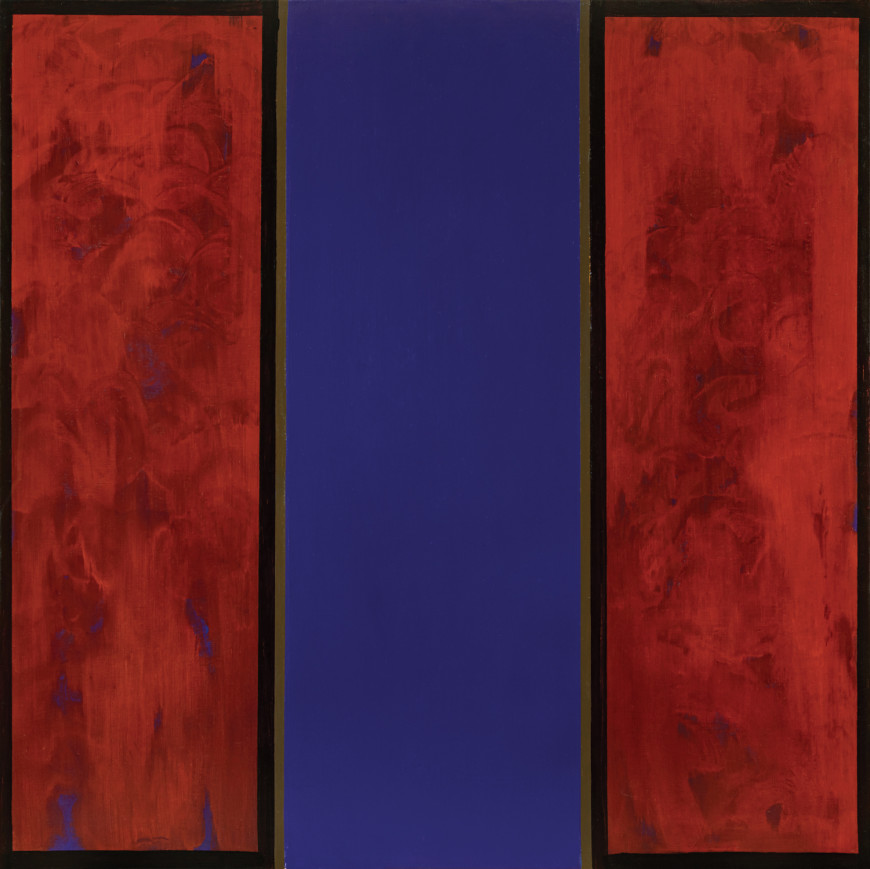-
Œuvres d'art
Jean McEwenA noir, corset velu des mouches éclatantes (Rimbaud), 1969 (circa)1923-1999Acrylic on canvas61 x 60 in
154.9 x 152.4 cmSoldInscriptions
inscribed, 'A noir, corset velu des mouches éclatantes (Rimbaud)' (verso, upper left)Provenance
Private Collection, Montreal.— A noir, corset velu des mouches éclatantes (A black, velvet jacket of brilliant flies) dates from the distinct period of 1965-1969 when McEwen abandoned oil for acrylic paint and received an honourable mention at the Sondage 68 exhibition at the Montreal Museum of Fine Arts (1968).
In the late 1960s McEwen shared a studio with Charles Gagnon (who had lived in New York) and Yves Gaucher, and the three experimented with hard-edge painting concurrent with leading artists of the period. Unlike their “Plasticiens” colleagues, however, Gagnon and McEwen combined solid fields of colour with areas of more impulsively applied paint varying in thickness, colour, and tone, as seen in the red field of this painting.
McEwen was an admirer of poetry and the title of the painting, A noir, corset velu des mouches éclatantes is a verse from the poem Voyelles (Vowels) by Arthur Rimbaud. Over the years, the poem appears to have inspired artists and been the subject of some discussion, apparently in part because of its own abstraction and intrigue, with some suggesting that Rimbaud related vowels to colours. In this case the vowel 'A' and 'black' appear in the title, and black appears in the painting. Colour was a notable concern of several leading Canadian hard-edge painters of the period, including Guido Molinari and Claude Tousignant. Whatever the meaning of Rimbaud's words and whatever McEwen's intentions, the painter did sometimes give his works titles derived from poems. One wonders if this painting might be part of a series of Rimbaud-vowel-inspired works.
A review of Charles Gagnon’s important Glory series of this same period, when it is posited that the latter “came into his own”, will reveal some similarities. McEwen was interested in colour, translucency, and light. The latter we can trace back to his appreciation of the French Impressionists, and perhaps to his “rediscovery” of Monet. With their expressionist fields of colour, McEwen’s paintings have sometimes drawn comparisons to some of the work of American painters Barnett Newman, Mark Rothko, and Sam Francis. McEwen had met Francis in Paris while visiting Jean Paul Riopelle, and the two shared an interest in light. In the forthcoming phases of his career McEwen would return to work in oil, deploying his paint in layers to further his investigations.
The experiments of McEwen and his colleagues put these artists at the vanguard of artistic developments in Canada and internationally. McEwen’s paintings can be found in collections which include those of the National Gallery of Canada, the Musée national des beaux-arts du Québec, and the Museum of Modern Art (MoMA) in New York. A noir, corset velu des mouches éclatantes is important testimony to McEwen’s evolution and to this period of art.
_________
Nasgaard, Roald, and Michel Martin. The Plasticiens and Beyond: Montreal, 1955-1970. Québec: Musée national des beaux-arts du Québec, 2013. Print, p. 101
Ibid











